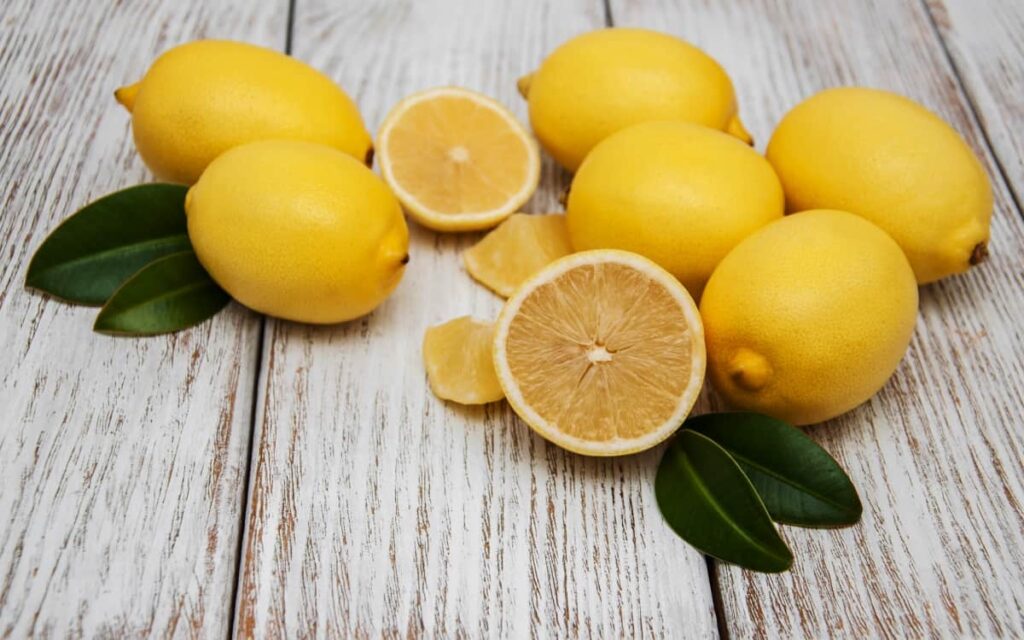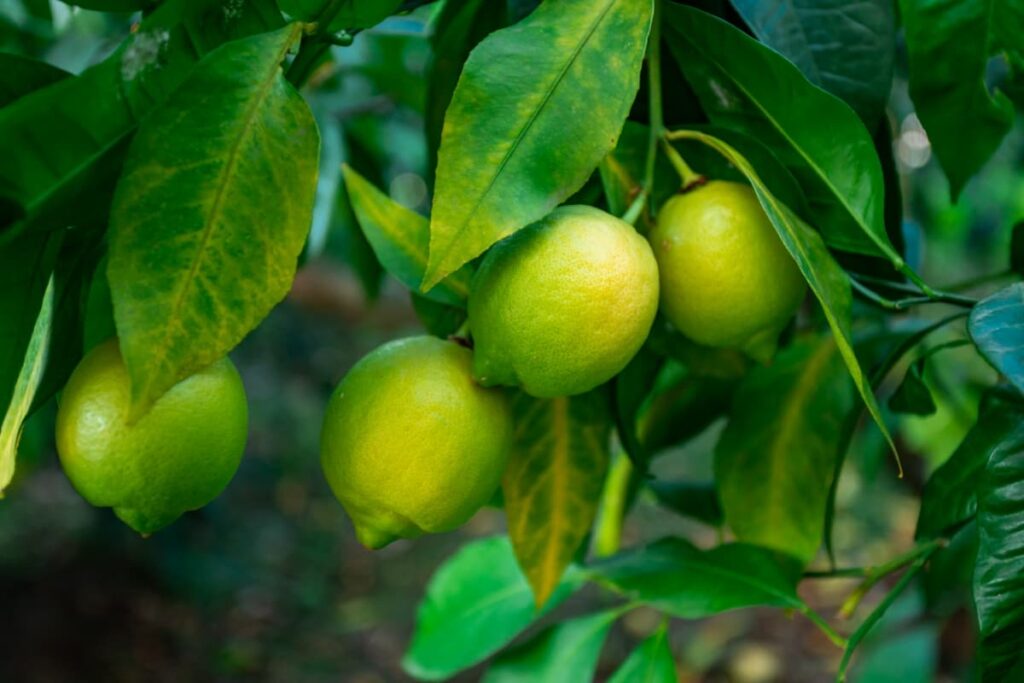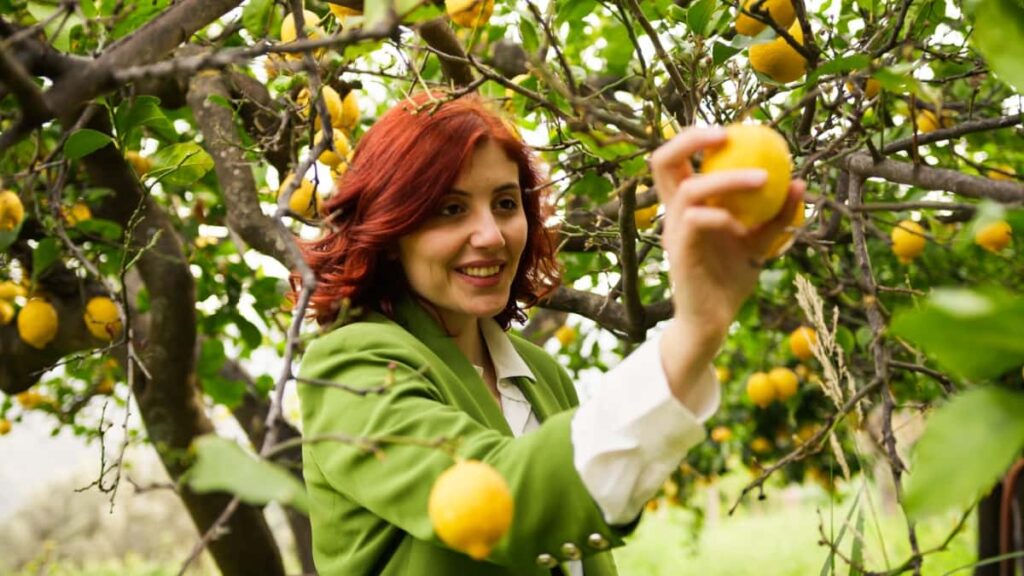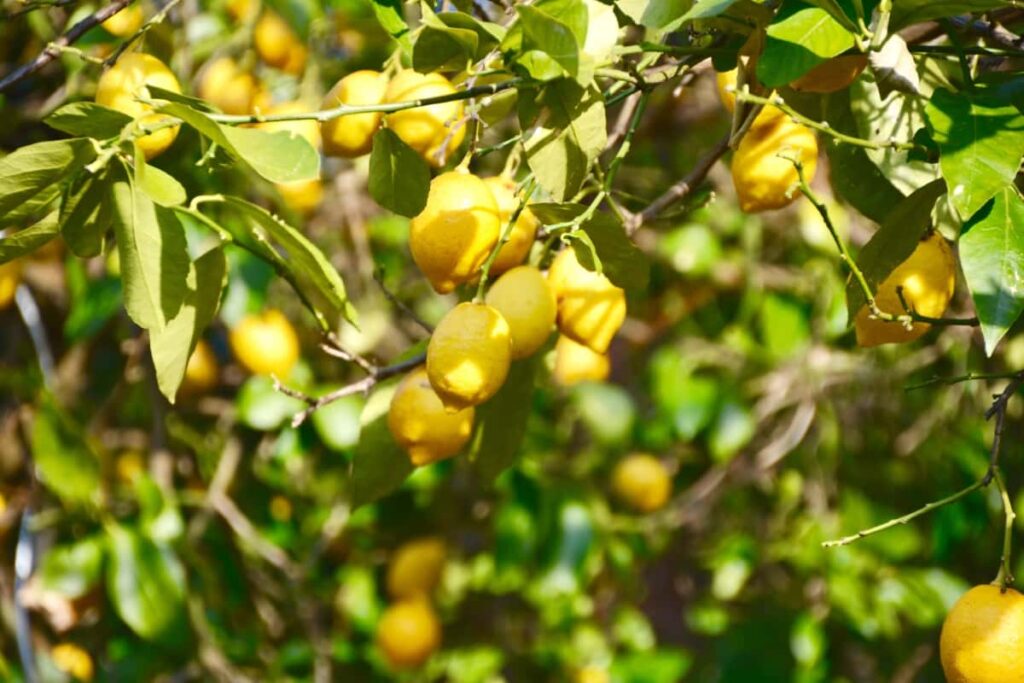Kagzi lemon is a Citrus limon known for its thick, bumpy skin and tangy flavor. Native to India, this variety is esteemed for its high juice content and robust aroma, making it popular in culinary and medicinal applications. Kagzi lemon cultivation offers numerous benefits, including high market demand, potential for year-round harvesting, and resilience to pests and diseases, making it a profitable venture for farmers.
Benefits of Growing Kagzi Lemons
Firstly, the high demand for Kagzi lemons in both local and international markets ensures a steady income for growers. Additionally, Kagzi lemon trees are known for their adaptability to diverse climatic conditions, making them suitable for cultivation in different regions. The fruit’s thick skin and extended shelf life enhance its marketability and transportability, reducing post-harvest losses. Moreover, Kagzi lemon trees exhibit resilience to common pests and diseases, minimizing the need for pesticide application.

Kagzi Nimboo Farming
Selecting the Right Soil for Kagzi Lemons
Ideal Soil Types for Kagzi Lemon Trees
Kagzi lemon trees thrive in well-drained soils with a slightly acidic to neutral pH (6.0-7.5. Loamy and sandy loam soils are ideal for their cultivation, providing good drainage and aeration essential for root development. Also, soils rich in organic matter promote nutrient availability and root health, contributing to vigorous tree growth and abundant fruit production.
Preparing Soil for Plantation
Soil preparation for Kagzi lemon involves clearing the site of any weeds, rocks, or debris that may obstruct root growth or drainage. Conduct a soil test to know nutrient levels and pH, amending the soil as necessary to achieve the ideal pH range of 6.0-7.5. Incorporate organic matter such as vermicompost or well-rotted manure to promote soil structure, fertility, and moisture retention. Properly tilling the soil helps loosen compacted layers and promotes root penetration.
Planting Kagzi Lemon Trees
Best Time to Plant Kagzi Lemons
Ideally, plant them during the spring months, after the last frost has passed and the soil has warmed up sufficiently. This timing allows the young trees to acclimate and establish strong root systems before the onset of harsh weather conditions. Spring planting also aligns with the active growth period of Kagzi lemon trees, maximizing their chances of thriving in their new environment.
Planting Techniques of Kagzi Lemon for Optimal Growth
Dig a hole that is as deep as the root ball. Carefully remove the Kagzi tree from its container or prepare bare-root seedlings, being mindful not to disturb the roots excessively. Place the tree in the center of the hole. Ensure that the graft union is above the soil line. Backfill the hole, firming it around the plants with soil to eliminate air pockets. Water the lemon trees to settle the soil and provide initial hydration to the tree.
Irrigation Practices for Kagzi Lemon Farming
Efficient Watering Methods for Lemon Trees
Drip irrigation or soaker hoses are recommended as they deliver water to the root zone directly, minimizing water loss through evaporation and runoff. Adequate Kagzi lemon irrigation practices are essential, especially during the tree’s active growth periods and fruit development stages. Monitor soil moisture regularly and adjust irrigation frequency and duration based on weather conditions and soil moisture levels.
Managing Water Needs During Different Seasons
During the growing season, typically spring and summer, Kagzi lemon trees have higher water requirements due to increased transpiration rates. Adjust irrigation frequency accordingly, ensuring consistent soil moisture without waterlogging. Reduce watering during the dormant winter months while still providing occasional deep watering to sustain the tree until the next growing season.
Nutrition and Fertilization for Kagzi Lemons
Essential Nutrients for Healthy Lemon Trees
Key nutrients for Kagzi lemon trees include nitrogen (N), potassium (K), phosphorus (P), magnesium (Mg), and calcium (Ca), and also micronutrients like iron (Fe), zinc (Zn), and manganese (Mn). Nitrogen promotes leaf and stem growth, whereas phosphorus supports root development and flower/fruit formation, and potassium enhances fruit quality and disease resistance. Calcium and magnesium are vital for cell structure and photosynthesis, respectively.
Organic vs. Chemical Fertilizers for Kagzi Lemons
Organic fertilizers for lemons, such as compost, manure, and organic amendments, improve soil structure, microbial activity, and long-term fertility. They release nutrients slowly, promoting sustainable growth and minimizing the risk of nutrient leaching. Chemical fertilizers, on the other hand, provide readily available nutrients for immediate uptake by the tree but may require careful application to prevent nutrient imbalances or environmental pollution.
In case you missed it: High Yield Hybrid Lemon Varieties in India

Pest and Disease Management in Kagzi Lemon Farming
Common Pests in Kagzi Lemon Cultivation
Common pests in Kagzi lemon cultivation include citrus psyllids, aphids, citrus leafminers, and mites. Pesticides like neem oil, insecticidal soaps, and horticultural oils are effective against soft-bodied pests like aphids and psyllids. For more persistent pest management in lemon farming, synthetic pesticides like pyrethroids or systemic insecticides may be necessary. Still, their use should be reasonable to minimize environmental impact and preserve beneficial insects.
Disease Prevention Strategies for Healthy Lemons
Practice proper sanitation by clearing fallen leaves and fruit debris that can harbor pathogens. Avoid overhead irrigation to minimize leaf wetness and fungal infections. Apply copper-based fungicides during the dormancy to prevent diseases like citrus canker and anthracnose. Plant disease-resistant lemon varieties when possible and maintain proper spacing between trees to improve air circulation and Kagzi lemon disease prevention.
Pruning and Maintenance of Kagzi Lemon Trees
When and How to Prune for Maximum Yield
Pruning Kagzi lemon trees during the dormant period, typically in late winter or spring, before new growth emerges. Remove dead, diseased, or crossing branches to improve airflow and light penetration within the canopy, which promotes fruit development and reduces disease incidence. Maintain an open canopy structure to facilitate harvesting and pest management.
Maintenance Tips for Long-Term Health
Provide adequate irrigation and fertilization to support healthy growth and fruit production. Mulch around the base of the tree to conserve soil moisture and suppress weed growth. Monitor soil pH and nutrient levels, amending as necessary to maintain optimal growing conditions.
Harvesting Kagzi Lemons
Identifying the Right Time to Harvest
Typically, harvesting techniques for lemons when they reach full size and develop a bright yellow color. However, for culinary purposes, they can be harvested while still green. Test fruit readiness by gently squeezing—ripe lemons will yield slightly to pressure. Additionally, monitor the tree’s flowering and fruiting patterns to gauge optimal harvest timing.
Techniques for Harvesting Lemons without Damaging Trees
Use sharp pruning shears or hand clippers to cut the fruit from the tree carefully, leaving a short stem attached to the lemon. Avoid pulling or twisting the fruit, which can damage the tree and affect future fruit production. Handle harvested lemons gently to prevent bruising or skin damage. Harvest regularly throughout the season to encourage continuous fruit production and maintain tree health.
Post-Harvest Handling and Marketing of Kagzi Lemons
Storage and Packaging for Kagzi Lemons
As post-harvest handling Kagzi lemon, Kagzi lemons should be stored in a cool, well-ventilated area away from direct sunlight to maintain freshness and extend shelf life. Optimal storage temperature ranges between 7-10°C with relative humidity around 85-90%. Pack lemons in ventilated biodegradable crates or boxes to avoid moisture buildup and minimize the risk of decay.
Strategies for Marketing and Selling Your Produce
For Marketing Kagzi lemons, establish relationships with local markets, grocery stores, restaurants, and wholesalers. Highlight the unique qualities of Kagzi lemons, such as their high juice content and aromatic zest, to attract customers. Utilize platforms in online and social media to showcase your produce and reach a wider audience. Offer samples or demonstrations to educate consumers about the uses and benefits of Kagzi lemons.
In case you missed it: How to Grow a Finger Lime in Pots from Seed and Cuttings: Explore from Planting to Harvest

Sustainable Kagzi Lemon Farming
Implementing Eco-Friendly Farming Techniques
Adopt integrated pest management (IPM) strategies to reduce reliance on synthetic pesticides, including beneficial insect release, crop rotation, and habitat conservation. Implement water-saving irrigation methods like drip irrigation or micro-sprinklers to optimize water use efficiency. Utilize organic fertilizers, compost, and cover crops to enhance soil fertility and structure while reducing reliance on chemical inputs.
Benefits of Sustainable Agriculture for Kagzi Lemon Cultivation
By reducing chemical inputs and promoting natural pest control methods, sustainable farming practices help maintain ecosystem balance and preserve beneficial insects, contributing to long-term pest management and reduced pesticide resistance. Improving soil health through organic amendments and conservation practices enhances nutrient cycling and water management lemon cultivation, resulting in improved crop yields and resilience to environmental stressors.
In case you missed it: How to Grow Kaffir Lime in a Pot: Growing from Seed and Cuttings in Containers

Conclusion
Kagzi lemon farming requires a comprehensive understanding of cultivation practices. By implementing efficient irrigation, nutrition management, and pruning strategies, growers can optimize yields and quality; Kagzi lemon farming offers a rewarding venture with potential for profitability and environmental stewardship.
- Budget Friendly Sheep Shed Ideas: Cheap and Low-Cost Tips
- How Much Do Cattle Farmers Make: Revenue Streams in Cattle Farming
- Management Pests and Diseases in Your Cotton Field
- Sheep Farming Business Plan for Beginners
- Aquaponic Farming at Home: A Step-By-Step Guide
- Profitable Village Farming Business Ideas in 2024
- High-Yield Aquaculture: Fast-Growing Fish for Farming
- Effective Fish Pond Construction Techniques for Beginners
- Irrigation and Water Management in Pineapple Farming
